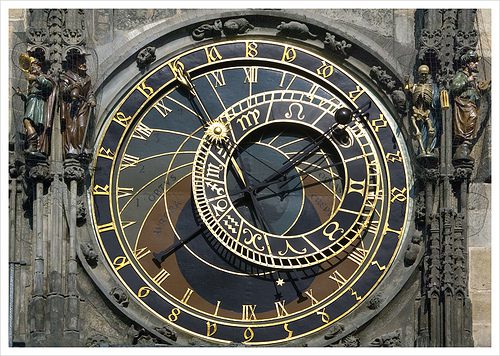Humans have sought to track the passing of the seasons, the days, and hours since before recorded history began.
From at least 3500BC the ancient Egyptians made use of timekeeping devices. At first, the sun and moon provided reference by way of its placement in the sky.
Anyone who has tried to tell the time that way, or wanted to use the sun’s position as a reference for a meeting, knows that the method has its limitations.
Hence, timekeeping inventions progressed over the centuries until finally culminating in the most accurate timekeeping imaginable, the atomic clock.
Telling Time Before Clocks
Obelisks and sundials
Obelisks and sundials tracked the movement of the sun with obelisks and other varieties of sundials such as movable-gnomon dials, altitude dials, and sundials with fixed axial gnomon. These are all fancy names for the types of dials which different cultures around the world used to measure time of day based on a shadow cast by the sun.
Water clocks
Water clocks predate the familiar hourglass and were one of the earliest timekeeping inventions. While sun dials were used in Ancient Egypt, they were not useful at night or on cloudy days. Hence, the invention of water clocks. These are similar to the hourglass in that time is measured based on the reduction of some material, in this case water.
Water clocks might have consisted of one jug spilling slowly onto the ground out of a small hole – the water level would then be measured with a stick to indicate the elapsed time. In some cases, the water might have spilled into a cup and the rising water level of inside that cup indicated the time.
The hourglass
The hourglass was a later invention, somewhat more sophisticated, which adjoined the two cups into one unit and, instead of dripping water, it dropped grains of sand, which is not subject to evaporation.
A stick of time
A stick of time was a measure of time often used in Japan. The number of incense sticks it took to burn during a given time frame indicated the time of day or expected arrival time.
Counting the Hours
Clocks
Clocks as we know them required the division of a day into 24 hours. Timekeeping began getting more precise and divided into more segments throughout history. In Europe, monks needed to keep time for the prayers that took place six times a day, and in the 14th century the days were finally divided up into 24 segments as they are today. Clocks soon marked the hours via the ringing of the bells in abbeys for the monks and towns’ people. In fact, the word clock is derived from the German word Glocke, meaning bell.
Wrist watches
Wrist watches were mechanical timepieces based on wheels, springs, and pulleys. They revolutionized the way the public kept track of time. Just as in the late 90s everyone started carrying cell phones, in the early 1900s everyone started carrying watches.
The atomic clock
The atomic clock was invented in 1949 and is the most accurate clock to date. While time pieces of old relied on the sun, water, sand, and pendulums, the atomic clock is based on the spin property of the cesium atom.
The atomic clock calibrates our clocks for the timestamps on Timesheets.com. You can rest assured that the timestamp of an employee’s clock punch is always the most accurate record of time possible by today’s standards.
In Part 2 of this series I will explore the history of time tracking devises.
For a painfully in depth look at all of these clocks and more visit Wikipedia’s History of Timekeeping Devices






2 Responses